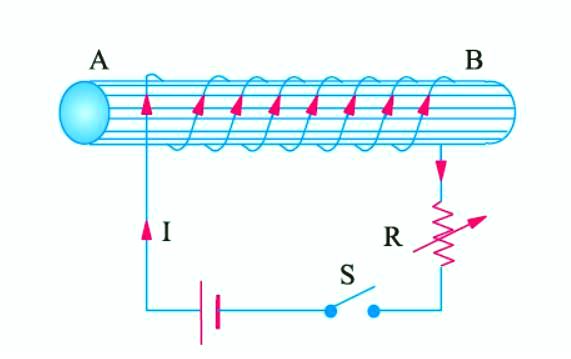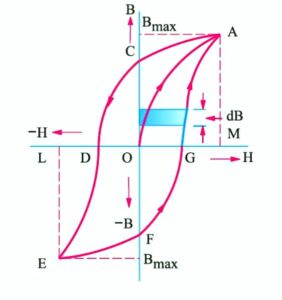Magnetic Hysteresis and Area of Hysteresis Loop
Magnetic Hysteresis
Magnetic Hysteresis may be defined as the lagging of magnetisation or induction flux density (B) behind the magnetising force (H). Alternatively, it may be defined as that quality of a magnetic substance, due to which energy is dissipated in it, on the reversal of its magnetism.
Let us take an unmagnetised bar of iron AB and magnetise it by placing it within the field of a solenoid (Figure given below). The field H (= NI/l) produced by the solenoid is called the magnetising force.

The value of H can be increased or decreased by increasing or decreasing current through the coil. Let H be increased in steps from zero up to a certain maximum value and the corresponding values of flux density (B) be noted. If we plot the relation between H and B, a curve like OA, as shown in the figure given below, is obtained. The material becomes magnetically saturated for H = OM and has at that time a maximum flux density of Bmax established through it.
AdBlock-2

If H is now decreased gradually (by decreasing solenoid current), flux density B will not decrease along AO, as might be expected, but will decrease less rapidly along AC. When H is zero, B is not but has a definite value Br = OC. It means that on removing the magnetising force H, the iron bar is not completely demagnetised. This value of B (= OC) measures the retentivity or remanence of the material and is called the remainent or residual flux density Br.
To demagnetise the iron bar, we have to apply the magnetising force in the reverse direction. When H is reversed (by reversing current through the solenoid), then B is reduced to zero at point D where H = OD. This value of H required to wipe off residual magnetism is known as coercive force (Hc) and is a measure of the coercivity of the material i.e. its ‘tenacity’ with which it holds on to its magnetism.
If, after the magnetisation has been reduced to zero, value of H is further increased in the ‘negative’ i.e. reversed direction, the iron bar again reaches a state of magnetic saturation, represented by point L. By taking H back from its value corresponding to negative saturation, (= OL) to its value for positive saturation (= OM), a similar curve EFGA is obtained. If we again start from G, the same curve GACDEFG is obtained once again.
It is seen that B always lag behind H. The two never attain zero value simultaneously. This lagging of B behind H is given the name ‘hystereis’ which literally means ‘to lag behind’. The closed loop ACDEFGA which is obtained when iron bar is taken through one complete cycle of magnetisation is known as ‘hypothesis loop’. By one cycle of magnetisation of a magnetic material is meant its being carried through one reversal of magnetisation.
Area of Hysteresis Loop
Just as the area of an indicator diagram measures the energy made available in a machine, when taken through one cycle of operation, so also the area of the hysteresis loop represents the net energy spent in taking the iron bar through one cycle of magnetisation.
According to Weber’s Molecular Theory of magnetism, when a magnetic material is magnetised, its molecules are forced along a straight line. So, energy is spent in this process. Now, if iron has no retentivity, then energy spent in straightening the molecules could be recovered by reducing H to zero in the same way as the energy stored up in a spring can be recovered by allowing the spring to release its energy by driving some kind of load. Hence, in the case of magnetisation of a material of high retentivity, all the energy put into it originally for straightening the molecules is not recovered when H is reduced to zero. We will now proceed to find this loss of energy per cycle of magnetisation.
Let l = mean length of the iron bar ; A = its area of cross-section; N = No. of turns of wire of the solenoid.
If B is the flux density at any instant, then Φ = BA.
When current through the solenoid changes, then flux also changes and so produces an induced e.m.f. whose value is
![]()
![]()
The power or rate of expenditure of energy in maintaining the current ‘I’ against induced e.m.f. ‘e’ is
![]()
Energy spent in time ![]()
Total net work done for one cycle of magnetisation is
W = Al H dB joule
where ![]() stands for integration over the whole cycle. Now, ‘H dB’ represents the shaded area in the figure given below. Hence,
stands for integration over the whole cycle. Now, ‘H dB’ represents the shaded area in the figure given below. Hence, ![]() HdB = area of the loop i.e. the area between the B/H curve and the B-axis
HdB = area of the loop i.e. the area between the B/H curve and the B-axis
∴ work done/cycle = Al × (area of the loop) joule. Now Al = volume of the material
∴ net work done/cycle/m3 = (loop area) joule, or Wh = (Area of B/H loop) joule m3/cycle

Read article – Units of Resistivity
Visit NCERTplanet.com for NCERT solutions and Textbook downloads




